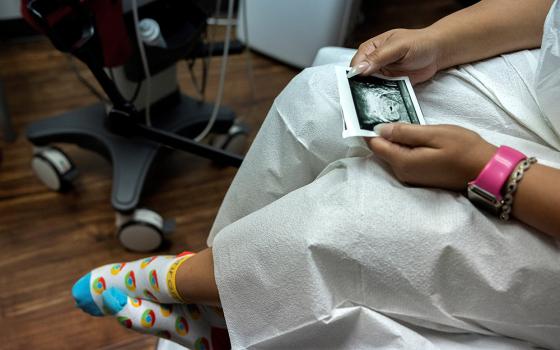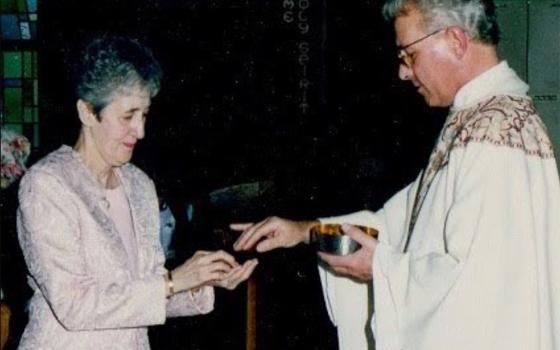
This figurine of Our Lady of Charity dressed in splendor is displayed in Coral Gables, Florida, Sept. 8, 2018, for the annual celebration of her feast day. (CNS/Ana Rodriguez-Soto, The Florida Catholic)
There's nothing more Cuban than black beans and rice, and of course, Our Lady of Charity, whose feast is celebrated on Sept. 8. The significance of this feast day was not lost on Joe Biden, who issued a statement praying that the "love and compassion" she inspires "will fill the hearts of believers around the world." The patroness of the island, for many Cuban Americans she is a bearer of social-cultural memories. For Cuban American Catholics like myself, she is also a religious symbol tied to familial devotions, popular faith practices and my Cuban exile.
My relationship to Our Lady of Charity began when I was a child still living in Cuba. While most of my childhood memories remain repressed, there's one that I vividly recall. As my parents and I were preparing to leave the island in 1972, I remember Cuban officials coming for the final inspection of my parents' apartment. It was customary for government officials to inspect the property and belongings of Cubans prior to their departure and to seal the property to indicate the government's repossession. Only seconds after the officials sealed my parents' door, I recall my mother's unsuccessful plea to be allowed back in to retrieve an image of Nuestra Señora de la Caridad del Cobre that had belonged to my maternal grandmother. Mi abuelita had given it to my mother before departing Cuba. That Virgen de la Caridad never left the island, symbolically mirroring the family, friends, and familiar faces we left behind.
A second image of Cachita, as we Cubans and Cuban Americans affectionately call her, is also part of my familial story. My mother tells me that my grandmother bought it during the brief time she lived as an exile in Mexico as she waited to fly to Miami. Mi abuela had left Cuba to reunite with her son (mi tío), his wife and their daughter. She had hoped that by doing so it would be easier for my parents and me to immigrate to the United States. After she passed away, I inherited her statue of the Virgin of Charity. This Cachita now sits in my home overlooking Lake Michigan.

Picture taken by Miguel H. Díaz of his abuela's statue of Our Lady of Charity on the shore of Lake Michigan (Provided photo)
At present, these two images evoke for me a tale of two countries and their leaders. They raise personal, communal and social-political memories that recall the turbulent times I left behind as a child. They also connect this past to the social turbulence that we currently experience in these United States of America. Issues of racism, heterosexism, political polarization, ideological demagoguery, attacks on the free press, violence resulting from armed injustice, and even the manipulation of religion — these are all issues Cubans experienced, and prompted many to leave the island. These are issues all of us now face as "Americans" in this country.
Devotion to Our Lady of Charity originated in the 17th century while Cuba was under Spanish rule. Her "birthplace" was in the northeastern part of the island near El Cobre, a copper mining community where enslaved Indigenous and Black workers labored. The protagonist of the story is Juan Moreno, identified as a slave and portrayed as Black in subsequent images. In 1687, he provided Spanish authorities with testimony detailing the finding of the statue of Our Lady of Charity earlier in his life when he was a child. This testimony was discovered in 1973 by the Cuban historian Leví Marrero in the archives of the Indies in Seville, Spain.
Moreno recounts how, as a 10-year-old boy, he went with two indigenous brothers, Rodrigo and Juan de Hoyos, to gather salt in the Bay of Nipe. As they rowed their canoe in the bay, they noticed a floating object, which they thought looked like a dove or a little girl. Once they got close enough, they realized it was a statue bearing the inscription: "Yo soy la Virgen de la Caridad," in other words, "I am the Virgin of Charity."
They carried the statue back with them to their copper-mining pueblo. This image of la Virgen resided in this community composed of Indigenous, enslaved and free Africans, and their descendants, and has many miracles attributed to her intercession. As I have written before in From the Heart of Our People, it is no surprise that when this statue arrived in El Cobre, she was first placed in the chapel of the hospital that served those who were enslaved. Situated among the most vulnerable and suffering, this placement symbolized her accompaniment of and preferential relationship with those who struggle to survive.
This image has a long history of solidarity with communities facing life-threatening situations. In Cuban history, la Virgen de la Caridad has been closely linked with movements for freedom from oppression and dictatorial forms of government. For example, the mambises, the Cuban social protestors who fought against Spanish colonial injustices, wore her medal as a sign of protection during their 1868 struggle for Cuban independence. Over time, Nuestra Señora de la Caridad became tied to Cuban national identity and, in the latter part of the 20th century, to those who fled into exile. For those who left everything behind or who braved difficult journeys, Cachita preserved our familial, cultural and religious memories in new lands and alien spaces. She symbolized the struggle for liberation and embodied a hope in God's will to lift up the lowly, scatter the proud, and bring down the powerful from their thrones (Luke 1:46-55).
For Cuban American Catholics in particular, how might this popular tradition speak to the current state of affairs in the U.S.? First and foremost, the devotion highlights the non-negotiable Christian option for the most vulnerable members of our society. In 1987, the Cuban bishops reminded us that the story of our Lady of Charity begins among "representatives of Cuba's most exploited and poor classes: two Indians and a black slave, whom she fills with the joy of her presence."
Advertisement
If it is in the company of the community of El Cobre that Cachita first manifests the healing presence of God through appearances and miracles, then where are we called to be as a nation during this unprecedented health crisis that has disproportionately impacted those who are poor, elderly, and marginalized? Who are we called to accompany as those who are Black, Indigenous, and Latinx bear the burden of COVID-19 damage? As we contemplate our decisions in this time of national and local elections, Cachita's solidarity with Moreno and the de Hoyos brothers invites us to consider the types of responses and kinds of leaders we want to represent all of us. If healing our nation and embodying the virtue of charity are to be priorities, we must choose leaders who favor policies that seek to protect the physical, emotional and mental health of our bodies and preserve the dignity of our social body.
Second, over time the three original witnesses that brought Cachita from the waters of the bay to the community of El Cobre came to symbolize Cuban identity, one people out of three roots: Indigenous, African, Iberian. Collectively named los tres Juanes they come to be "a singular Juan, one Juan, one and triune: Juan the Cuban people, our indoafrohispanic people," as I wrote in my book. This shift is reflected in subsequent artistic representations that depict the individual salt gatherers in the boat as one Indigenous, one African, one Spaniard.
Notwithstanding some positive aspects of this evolution, we cannot afford to be naive. As Cuban Americans, we know from our own familial and national histories, that the Spanish, the Indigenous, and the African were not accorded the same place in Cuban society. Our Indigenous people were all but wiped out due to epidemics and violence. Afro-Cubans not only experienced physical violence, but they also suffered because of chattel slavery and the sin of racism. In our quest for unity, we must take care not to erase the names, faces, stories and discomforting memories of the suffering experienced by the Juan Morenos and the Rodrigo and Juan de Hoyos of this world.
In seeking to birth oneness out of diversity, how can we move forward together to envision a more just social order that truly reflects, in words and deeds, our U.S. national founding principle, e pluribus unum, out of many, one? The street protests arising out of generations of frustration with racial injustice and social inequities point to systemic and sinful social disorders that must be challenged and changed. In the aftermath of George Floyd's death, and the deaths of countless others known and unknown to us, it is time to engage the hard work of building authentic communities. It is time in the U.S. to set aside both romanticized and false constructions of national unity, especially if they are propelled by hyperbole or unwarranted fears that seek to avoid uncomfortable truths.
Many Cuban Americans annually participate in the Sept. 8 celebrations organized at La Ermita in Miami to commemorate the feast. This Cuban shrine houses a statue of Our Lady of Charity, which was smuggled onto U.S. soil in 1961. During this celebration, Cuban Americans can be heard shouting, "¡Virgen de la Caridad, salva a Cuba, Virgin of Charity save Cuba!" It is a heartfelt cry for salvation understood in terms of the sociopolitical liberation of a people, a homeland, and a longing for roots left behind.
During this time of multiple national crises, as a Cuban American who was born in Cuba and raised in this country and who has served the United States as an ambassador, I find myself praying, "¡Virgen de la Caridad salva a los Estados Unidos!"
[Miguel H. Díaz is the John Courtney Murray University Chair in Public Service at Loyola University in Chicago. He was ambassador to the Holy See during the first administration of President Barack Obama.]
Editor's note: We can send you an email alert every time a Theology en la Plaza column is posted to NCRonline.org. Go to this page and follow directions: Email alert sign-up.







